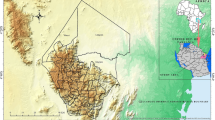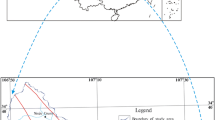Abstract
Ardesen is a settlement area which has been significantly damaged by frequent landslides which are caused by severe rainfalls and result in many casualties. In this study a landslide susceptibility map of Ardesen was prepared using the Analytical Hierarchy Process (AHP) with the help of Geographical Information Systems (GIS) and Digital Photogrametry Techniques (DPT). A landslide inventory, lithology–weathering, slope, aspect, land cover, shear strength, distance to the river, stream density and distance to the road thematics data layers were used to create the map. These layer maps are produced using field, laboratory and office studies, and by the use of GIS and DPT. The landslide inventory map is also required to determine the relationship between these maps and landslides using DPT. In the study field in the Hemsindere Formation there are units that have different weathering classes, and this significantly affects the shear strength of the soil. In this study, shear strength values are calculated in great detail with field and laboratory studies and an additional layer is evaluated with the help of the stability studies used to produce the landslide susceptibility map. Finally, an overlay analysis is carried out by evaluating the layers obtained according to their weight, and the landslide susceptibility map is produced. The study area was classified into five classes of relative landslide susceptibility, namely, very low, low, moderate, high, and very high. Based on this analysis, the area and percentage distribution of landslide susceptibility degrees were calculated and it was found that 28% of the region is under the threat of landslides. Furthermore, the landslide susceptibility map and the landslide inventory map were compared to determine whether the models produced are compatible with the real situation resulting in compatibility rate of 84%. The total numbers of dwellings in the study area were determined one by one using aerial photos and it was found that 30% of the houses, with a total occupancy of approximately 2,300 people, have a high or very high risk of being affected by landslides.
Similar content being viewed by others
References
Anbalagan R (1992) Landslide hazard evaluation and zonation mapping in mountainous terrain. Eng Geol 32:269–277
Anbalagan R, Singh B (1996) Landslide hazard and risk assessment mapping of mountainous terrains: a case study from Kumaun Himalaya, India. Eng Geol 43:237–246
Ayalew L, Yamagishi H, Ugawa N (2004) Landslide susceptibility mapping using GIS-based weighted linear combination, the case in Tsugawa area of Agano River, Niigata Prefecture, Japan. Landslides 1:73–81
Ayalew L, Yamagishi H (2005) The application of GIS-based logistic regression for landslide susceptibility mapping in the Kakuda–Yahiko Mountains, central Japan. Geomorphology 65:15– 31
Ayalew L, Yamagishi H, Marui H and Kano T (2005) Landslides in Sado Island of Japan: Part II. GIS-based susceptibility mapping with comparisons of results from two methods and verifications. Geomorphology 81:432– 445
Barredo JI, Benavides A, Hervas J, van Westen CJ (2000) Comparing heuristic landslide hazard assessment techniques using GIS in the Tirajana basin, Gran Canaria Island, Spain. International Int J Appl Earth Observ Geoinform 2:9 –23
Carrara A, Cardinali M, Detti R, Guzzetti F, Pasqui V, Reichenbach P (1991) GIS techniques and statistical models in evaluating landslide hazard. Earth Surf Proc Landf 16:427–445
Carrara A, Cardinalli M, Guzzetti F (1992) Uncertainty in assessing landslide hazard and risk, ITC J 2:172–183
Carrara A, Guzzetti F, Cardinalli M, Reichenbach P (1999) Use of GIS technology in the prediction and monitoring of landslide hazard. Nat Hazards 20:117–135
Çevik E, Topal T (2003) GIS-based landslide susceptibility mapping for a problematic segment of the natural gas pipeline, Hendek (Turkey). Environ Geol 44:949–962
Chandler JH (1999) Effective application of automated digital photogrammetry for geomorphological research. Earth Surf Process Landf 24:51–63
Chi K, Lee K, Park N (2002) Landslide stability analysis and prediction modeling with landslide occurrences on KOMPSAT EOC imagery. Korean J Remote Sensing 18(1):1–12
Clerici A, Perego S, Tellini C, Vescovi P (2002) A procedure for landslide susceptibility zonation by the conditional analysis method. Geomorphology 48:349–364
Dai FC, Lee CF, Li J, Xu ZW (2001) Assessment of landslide suspectibility on the natural terrain of Lantau Island, Hong Kong. Environ Geol 43(3):381–391
Dai FC, Lee CF and Ngai YY (2002) Landslide risk assessment and management: an overview. Eng Geol 64(1):65–87
Eastman JR, Jin W, Kyem PAK, Toledano J (1995) Raster Procedures for multi-criteria/multi-objective decisions. Photogr Eng Remote Sensing 61(5):539–547
Einstein HH (1988) Special lecture: Landslide risk assessment procedure. In: Proc. V Int Symp on Landslides. Lausanne 2:1075–1090
Ercanoğlu M, Gökçeoğlu C, Van Asch THWJ (2004) Landslide susceptibility zoning north of Yenice (NW Turkey) by multivariate statistical techniques. Nat Hazard 32:1–23
Fernandez CI, Del Castillo TF, El Hamdouni R, Montero JC, (1999) Verification of landslide susceptibility mapping: a case study. Earth Surface Proc Landf 24:537–544
Frattini P, Crosta GB, Fusi N, Dal Negro P (2004) Shallow landslides in pyroclastic soils: a distributed modelling approach for hazard assessment. Eng Geol 73(3–4):277–295
Gökçeoğlu C, Aksoy H (1996) Landslide susceptibility mapping of the slopes in the residuel soils of the Mengen region (Turkey) by deterministic stability analyses and image processing techniques. Eng Geol 44:147–161
Griffiths JS, Mather AE, Hart AB (2002) Landslide susceptibility in the Rio Aguas catchment, SE␣Spain. Q J Eng Geol Hydrogeol 35:9–17
Guzzetti F, Carrara A, Cardinalli M, Reichenbach P (1999) Landslide hazard evaluation: a review of current techniques and their application in a multi-scale study, Central Italy. Geomorphology 31:181–216
Guzzetti F, Cardinalli M, Reichenbach P, Carrara A (2000) Comparing landslide maps: a case study in the upper Tiber river basin, Central Italy. Environ Manage 25(3):247–263
ISRM (1981) Rock characterization testing and monitoring (ISRM suggested methods), Editor, Royal School of Mines, Imperial college of Science and Technology, London
Jade S, Sarkar S (1993) Statistical models for slope instability classification. Eng Geol 36:91–98
Juang CH, Lee DH, Sheu C (1992) Mapping slope failure potential using fuzzy sets. J Geotech Eng ASCE 118(3):475–494
Karsli F, Yalcin A, Atasoy M, Demir O, Reis S, Ayhan E (2004) Landslide assessment by using digital photogrammetric techniques, XXth Congress International Society for Photogrametry and Remote Sensing (ISPRS), 12–23 July 2004, Istanbul
Kraus K (1993) Photogrammetry, vol 1. Ummler, Bonn
Komac M (2005) A landslide susceptibility model using the Analytical Hierarchy Process method and multivariate statistics in perialpine Slovenia, Geomorphology (in press)
Korkmaz S, Gedik A (1988) Geology of the Rize-Fındıklı-Çamlıhemşin area and petroleum occurrences. Geol Eng 32–33, 5–15 (in Turkish)
Koukis G, Ziourkas C (1991) Slope instability phenomena in Greece: A statistical analysis. Bull Int Assoc Eng Geol 43:47–60
Lan HX, Zhou CH, Wang LJ, Zhang HY, Li RH (2004) Landslide hazard spatial analysis and prediction using GIS in the Xiaojiang watershed, Yunnan, China. Eng Geol 76(1–2):109–128
Lee S (2005) Application of logistic regression model and its validation for landslide susceptibility mapping using GIS and remote sensing data. Int J Remote Sensing 26(7):1477–1491
Lee S, Min K (2001) Statistical analysis of landslide susceptibility at Yongin, Korea. Environ Geol 40:1095–1113
Lee S, Choi J, Min K (2004a) Probabilistic landslide hazard mapping using GIS and remote sensing data at Boun, Korea. Int J Remote Sensing 25(11):2037–2052
Lee S, Ryu J, Won J, Park H (2004b) Determination and application of the weight for landslide susceptibility mapping using an artificial neural network. Eng Geol 71:289–302
Luzi L, Pergalani F (1999) Slope instability in static and dynamic conditions for urban planning: the “Oltre Po Pavese” case history (Region Lombardia-Italy). Nat Hazards 20:57–82
Maharaj R (1993) Landslide processes and landslide susceptibility analysis from an upland watershed: a case study from St Andrew, Jamaica, West Indies. Eng Geol 34:53–79
Mejia-Navarro M, Garcia LA (1996) Natural hazard and risk assessment using decision support systems, Application: Glenwood Springs, Colorado. Environ Eng Geosci 2(3):299–324
Mejia-Navarro M, Wohl EE (1994) Geological hazard and risk evaluation using gis: methodology and model applied to Medellin, Colombia. Bull Assoc Eng Geol 31:459–481
Miles SB, Ho CL (1999) Rigorous landslide hazard zonation using newmark’s method and stochastic ground motion simulation. Soil Soil Dyn Earthq Eng 18:305–323
Moon V, Blackstock H (2004) A methodology for assessing landslide hazard using deterministic stability models. Nat Hazard 32:111–134
Nagarajan R, Roy A, Vinod Kumar R, Mukherjee A, Khire MV, (2000) Landslide hazard suspectibility mapping based on terrain and climatic factors for tropical monsoon regions. Bull Eng Geol Env 58:275–287
Nash D (1987) A comparative review of limit equilibrium methods of stability analysis. In: Anderson MG, Richards KS (eds) Slope stability. Wiley, Chichester, pp 11–75
Pachauri AK, Pant M (1992) Landslide hazard mapping based on geological attributes. Eng Geol 32:81–100
Pachauri AK, Gupta PV, Chander R (1998) Landslide zoning in a part of the Garhwal Himalayas. Environ Geol 36:325–334
Parise M (2001) Landslide mapping techniques and their use in the assessment of the landslide hazard. Phys Chem Earth (C) 26(9):697–703
Republic of Turkey, Prime Ministry State Institute of Statistics, 2002, http://www.die.gov.tr, Cited 16 April 2004
Saaty TL (1977) A scaling method for priorities in hierarchical structures. J Mathemat Psychol 15:234– 281
Saaty TL (1980) The analytical hierarchy process. McGraw Hill, New York, p 350
Saaty TL (1990) The analytic hierarchy process, 2nd edn. RWS Publications, Pittsburg, p 286
Saaty TL (1994) How to make a decision: the analytic hierarchy process. Interfaces 24(6):19–43
Saaty TL, Vargas LG (1991) Prediction, projection and forecasting. Kluwer Academic Publisher, Dordrecht
Saaty TL, Vargas GL (2001) Models, methods, concepts, and applications of the analytic hierarchy process. Kluwer Academic Publisher, Boston
Saha AK, Gupta RP, Arora MK (2002) GIS-based landslide hazard zonation in the Bhagirathi (Ganga) valley, Himalayas. Int J Remote Sensing 23(2):357–369
Schenk T (1999) Digital photogrammetry. TerraScience, Ohio
Skempton AW, DeLory FA (1957) Stability of natural slopes in London Clay. Proceedings of the 4th International Conference on Soil Mechanics and Foundation Engineering 2, London, pp. 378–381
Temesgen B, Mohammed MU, Korme T (2001) Natural hazard assessment using GIS and remote sensing methods, with particular references to the landslides in the Wondogenet area, Ethiopia, Phys. Chem Earth (C) 26:665–675
Turrini MC, Visintainer P (1998) Proposal of a method to define areas of landslide hazard and application to an area of the Dolomites, Italy. Eng Geol 50:255–265
Uromeihy A, Mahdavifar MR, (2000) Landslide hazard zonation of the Khorshrostam area, Iran. Bull Eng Geol Env 58:207–213
Van Westen CJ, (1993) Remote sensing and geographic information systems for geological hazard mitigation. ITC J 4:393–399
Van Westen CJ (1994) GIS in landslide hazard zonation: a review with example from the Colombian Andes, In: Price MF, Heywood DI (eds) Taylor and Francis, London
Van Westen CJ and Bonilla JBA, (1990) Mountain hazard analysis using a PC-based GIS. Proceedings of the 6th International Congress of Engineering Geology, Amsterdam, Netherlands, DG Price (ed), Balkema, August 1990, pp. 265–271
Vargas LG (1990) An overview of the analytic hierarchy process and its applications. Eur J Oper Res 48:2–8
Varnes DJ (1984) Landslide hazard zonation: a review of principles and practices commision on landslides of the IAEG. UNESCO, Paris
Yalcin A, Reis S, Nişancı, R (2002) Mass movement evaluation with geographical information systems: a case study from Gumushane region. Proceedings International Symposium on Geographic Information Systems (GIS 2002), September 2002, Istanbul, pp 760–767
Yalcin A, (2005) An investigation on Ardesen (Rize) region on the basis of landslide susceptibility, KTU, PhD Thesis (in Turkish)
Author information
Authors and Affiliations
Corresponding author
Rights and permissions
About this article
Cite this article
Yalcin, A., Bulut, F. Landslide susceptibility mapping using GIS and digital photogrammetric techniques: a case study from Ardesen (NE-Turkey). Nat Hazards 41, 201–226 (2007). https://doi.org/10.1007/s11069-006-9030-0
Received:
Accepted:
Published:
Issue Date:
DOI: https://doi.org/10.1007/s11069-006-9030-0




